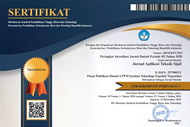Studi Perbandingan SNI Baja terhadap Metode Perhitungan Kekuatan Aksial Tekan pada Elemen Komposit Tabung Baja Berpengisi Beton
Abstract
This article provides information regarding the comparison of methods and results for calculating compressive strength in compression member composite elements of concrete filled steel tubes (CFST) based on three standards (SNI) related to the design and specifications of structural steel in buildings. The three standards being compared are SNI 03-1729-2002, SNI 1729-2015 and SNI 1729:2020. Hollow structural sections (HSS) are widely used as structural elements, then increase their strength and reliability, concrete is added as a filler, known as Concrete Filled Steel Tubes (CFST) Sections. In all three standards, there are the same concept and discussion. Meanwhile, different methods, formulas, and coefficients appear in the calculation of compressive axial strength for CFST, so there are different results. The design axial strength values based on SNI 1729-2015 and SNI 1729:2020 are coincide, even though there are different coefficients. Further, the calculation results of the two SNIs are smaller than SNI 03-1729-2002 due to significant change in the suggested reduction factor. Overall, based on this study, the existing CFST member designed using SNI 03-1729-2002 needs to be re-evaluated, especially in their axial force restraining contribution.
Keywords
Full Text:
PDFReferences
G. van der V. Wardenier, J; JA PAcker; XL Zhao, HOLLOW SECTIONS Hollow Sections in Structural Applications, no. December. 2010.
S. V. Devi, T. G. Singh, and K. D. Singh, “Cold-formed steel square hollow members with circular perforations subjected to torsion,” J. Constr. Steel Res., vol. 162, p. 105730, 2019.
M. Elchalakani, X. Zhao, and R. Grzebieta, “Axial Loading,” J. Strcutural Eng., vol. 129, no. April, pp. 507–514, 2003.
J. Sakai, “Current State of Studies of Steel-Concrete Composite Structure,” Steel Construction Today and Tomorrow, p. 1, 2018.
Yayasan Lembaga Penyelidikan Masalah Bangunan, Peraturan Perencanaan Bangunan Baja Indonesia. Indonesia, 1984.
Departemen Pekerjaan Umum, Tata Cara Perencanaan Struktur Baja untuk Bangunan Gedung. Jakarta, Indonesia: Badan Standarisasi Nasional, 2002.
W. Dewobroto, “Peraturan Baja Terkini SNI 1729 : 2015 dan Direct Analysis Method ( Metode Peraturan Baja Terkini SNI 1729 : 2015 dan Direct Analysis Method ( Metode Baru Perencanaan Baja Berbasis Komputer ),” in Seminar Nasional Peran dan Perkembangan SNI Menuju Pembangunan Infrastruktur Berkelanjutan, 2015.
American Institute of Steel Construction, Load and Resistance Factor Design Specification for Structural Steel Buildings. Uniter States of America, 1999.
F. Phiegiarto, J. E. Tjanniadi, H. Santoso, and I. Muljati, “Perencanaan Elemen Struktur Baja Berdasarkan SNI 1729 : 2015,” J. Dimens. Pratama Tek. Sipil, vol. 4, no. 2, pp. 1–8, 2015.
Komite Teknis 91-01 Bahan Konstruksi Bangunan dan Rekayasa Sipil, Spesifikasi untuk Gedung Baja Struktural. Indonesia, 2015.
American Institute of Steel Construction, Spesifications for Structural Steel Buildings. 2010.
Komite Teknis 91-01 Bahan Konstruksi Bangunan dan Rekayasa Sipil melalui, Spesifikasi untuk bangunan gedung baja struktural. Indonesia, 2020.
American Institute of Steel Construction, Specification for Structural Steel Buildings. United States of America, 2016.
A. Rizki Amalia and B. Suswanto, “Studi Perbandingan Kekuatan Aksial Rencana Profil WF Berdasarkan SNI 03-1729-2002 dan SNI 1729:2015,” Rekayasa J. Tek. Sipil, vol. 3, no. 1, 2018.
The British Constructional Steelwork Association Limited, Handbook of Structural Steel Woek, vol. 20, no. December. London, 2010.
Departemen Teknik Sipil ITS, Modul Konstruksi Baja. Surabaya, 2002.
J. C. McCormac and S. F. Csernak, Structural Steel Design. Pearson, 2012.
ACI Committee 318, Building Code Requirements for Structural Concrete. 2014.
Badan Standarisasi Nasional, SNI 03-2847:2019 Persyaratan Beton Struktural Untuk Bangunan Gedung, no. 8. 2019, p. 695.
K. Nakagawa, T. Ueki, and T. Nanba, “HBL 385 Series, 550 N/mm2 Class steel for building structures with good balance of excellent earthquake resistance and economic efficiency,” JFE Tech. Rep., vol. 19, no. 19, pp. 1–8, 2014.
DOI: http://dx.doi.org/10.12962%2Fj2579-891X.v22i2.20408
Refbacks
- There are currently no refbacks.

Jurnal Aplikasi Teknik Sipil by Pusat Publikasi Ilmiah LPPM Institut Teknologi Sepuluh Nopember is licensed under a Creative Commons Attribution-ShareAlike 4.0 International License
Based on work at https://iptek.its.ac.id/index.php/jats




